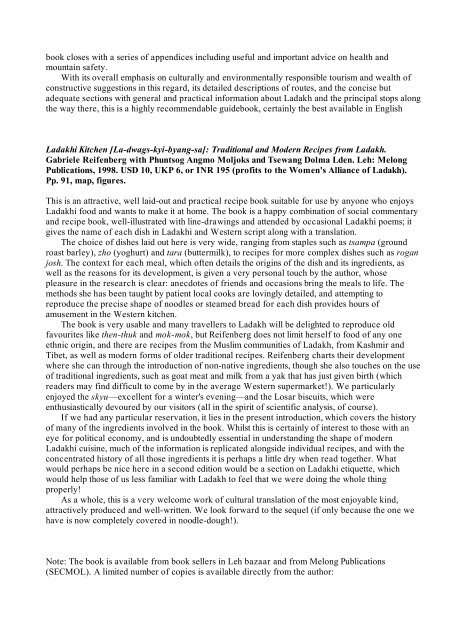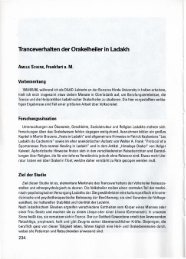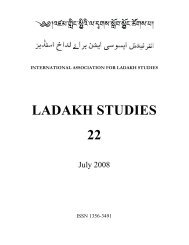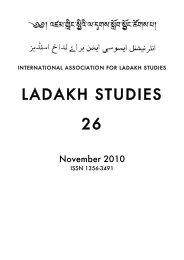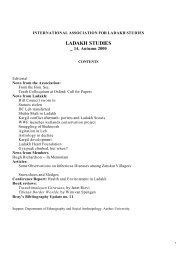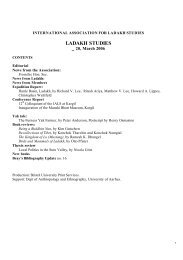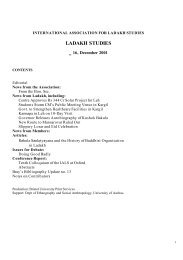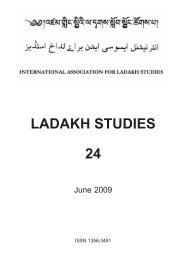LADAKH STUDIES 12, Autumn 1999 - International Association for ...
LADAKH STUDIES 12, Autumn 1999 - International Association for ...
LADAKH STUDIES 12, Autumn 1999 - International Association for ...
You also want an ePaper? Increase the reach of your titles
YUMPU automatically turns print PDFs into web optimized ePapers that Google loves.
ook closes with a series of appendices including useful and important advice on health and<br />
mountain safety.<br />
With its overall emphasis on culturally and environmentally responsible tourism and wealth of<br />
constructive suggestions in this regard, its detailed descriptions of routes, and the concise but<br />
adequate sections with general and practical in<strong>for</strong>mation about Ladakh and the principal stops along<br />
the way there, this is a highly recommendable guidebook, certainly the best available in English<br />
Ladakhi Kitchen [La-dwags-kyi-byang-sa]: Traditional and Modern Recipes from Ladakh.<br />
Gabriele Reifenberg with Phuntsog Angmo Moljoks and Tsewang Dolma Lden. Leh: Melong<br />
Publications, 1998. USD 10, UKP 6, or INR 195 (profits to the Women's Alliance of Ladakh).<br />
Pp. 91, map, figures.<br />
This is an attractive, well laid-out and practical recipe book suitable <strong>for</strong> use by anyone who enjoys<br />
Ladakhi food and wants to make it at home. The book is a happy combination of social commentary<br />
and recipe book, well-illustrated with line-drawings and attended by occasional Ladakhi poems; it<br />
gives the name of each dish in Ladakhi and Western script along with a translation.<br />
The choice of dishes laid out here is very wide, ranging from staples such as tsampa (ground<br />
roast barley), zho (yoghurt) and tara (buttermilk), to recipes <strong>for</strong> more complex dishes such as rogan<br />
josh. The context <strong>for</strong> each meal, which often details the origins of the dish and its ingredients, as<br />
well as the reasons <strong>for</strong> its development, is given a very personal touch by the author, whose<br />
pleasure in the research is clear: anecdotes of friends and occasions bring the meals to life. The<br />
methods she has been taught by patient local cooks are lovingly detailed, and attempting to<br />
reproduce the precise shape of noodles or steamed bread <strong>for</strong> each dish provides hours of<br />
amusement in the Western kitchen.<br />
The book is very usable and many travellers to Ladakh will be delighted to reproduce old<br />
favourites like then-thuk and mok-mok, but Reifenberg does not limit herself to food of any one<br />
ethnic origin, and there are recipes from the Muslim communities of Ladakh, from Kashmir and<br />
Tibet, as well as modern <strong>for</strong>ms of older traditional recipes. Reifenberg charts their development<br />
where she can through the introduction of non-native ingredients, though she also touches on the use<br />
of traditional ingredients, such as goat meat and milk from a yak that has just given birth (which<br />
readers may find difficult to come by in the average Western supermarket!). We particularly<br />
enjoyed the skyu—excellent <strong>for</strong> a winter's evening—and the Losar biscuits, which were<br />
enthusiastically devoured by our visitors (all in the spirit of scientific analysis, of course).<br />
If we had any particular reservation, it lies in the present introduction, which covers the history<br />
of many of the ingredients involved in the book. Whilst this is certainly of interest to those with an<br />
eye <strong>for</strong> political economy, and is undoubtedly essential in understanding the shape of modern<br />
Ladakhi cuisine, much of the in<strong>for</strong>mation is replicated alongside individual recipes, and with the<br />
concentrated history of all those ingredients it is perhaps a little dry when read together. What<br />
would perhaps be nice here in a second edition would be a section on Ladakhi etiquette, which<br />
would help those of us less familiar with Ladakh to feel that we were doing the whole thing<br />
properly!<br />
As a whole, this is a very welcome work of cultural translation of the most enjoyable kind,<br />
attractively produced and well-written. We look <strong>for</strong>ward to the sequel (if only because the one we<br />
have is now completely covered in noodle-dough!).<br />
Note: The book is available from book sellers in Leh bazaar and from Melong Publications<br />
(SECMOL). A limited number of copies is available directly from the author:<br />
42


